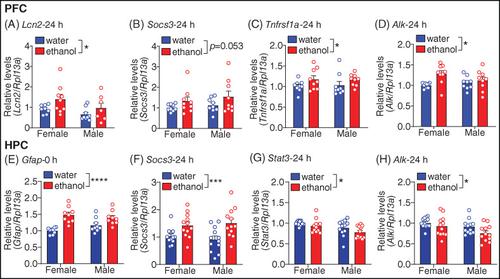当前位置:
X-MOL 学术
›
Genes Brain Behav.
›
论文详情
Our official English website, www.x-mol.net, welcomes your
feedback! (Note: you will need to create a separate account there.)
Binge-like ethanol drinking activates anaplastic lymphoma kinase signaling and increases the expression of STAT3 target genes in the mouse hippocampus and prefrontal cortex
Genes, Brain and Behavior ( IF 2.4 ) Pub Date : 2021-02-28 , DOI: 10.1111/gbb.12729 Kana Hamada 1, 2 , Laura B Ferguson 3, 4 , R Dayne Mayfield 3 , Harish R Krishnan 2 , Mark Maienschein-Cline 5 , Amy W Lasek 2
Genes, Brain and Behavior ( IF 2.4 ) Pub Date : 2021-02-28 , DOI: 10.1111/gbb.12729 Kana Hamada 1, 2 , Laura B Ferguson 3, 4 , R Dayne Mayfield 3 , Harish R Krishnan 2 , Mark Maienschein-Cline 5 , Amy W Lasek 2
Affiliation

|
Alcohol use disorder (AUD) has a complex pathogenesis, making it a difficult disorder to treat. Identifying relevant signaling pathways in the brain may be useful for finding new pharmacological targets to treat AUD. The receptor tyrosine kinase anaplastic lymphoma kinase (ALK) activates the transcription factor STAT3 in response to ethanol in cell lines. Here, we show ALK activation and upregulation of known STAT3 target genes (Socs3, Gfap and Tnfrsf1a) in the prefrontal cortex (PFC) and ventral hippocampus (HPC) of mice after 4 days of binge-like ethanol drinking. Mice treated with the STAT3 inhibitor stattic drank less ethanol than vehicle-treated mice, demonstrating the behavioral importance of STAT3. To identify novel ethanol-induced target genes downstream of the ALK and STAT3 pathway, we analyzed the NIH LINCS L1000 database for gene signature overlap between ALK inhibitor (alectinib and NVP-TAE684) and STAT3 inhibitor (niclosamide) treatments on cell lines. These genes were then compared with differentially expressed genes in the PFC of mice after binge-like drinking. We found 95 unique gene candidates, out of which 57 had STAT3 binding motifs in their promoters. We further showed by qPCR that expression of the putative STAT3 genes Nr1h2, Smarcc1, Smarca4 and Gpnmb were increased in either the PFC or HPC after binge-like drinking. Together, these results indicate activation of the ALK-STAT3 signaling pathway in the brain after binge-like ethanol consumption, identify putative novel ethanol-responsive STAT3 target genes, and suggest that STAT3 inhibition may be a potential method to reduce binge drinking in humans.
中文翻译:

暴饮暴食乙醇会激活间变性淋巴瘤激酶信号传导并增加小鼠海马和前额皮质中 STAT3 靶基因的表达
酒精使用障碍(AUD)具有复杂的发病机制,使其成为一种难以治疗的疾病。识别大脑中的相关信号通路可能有助于寻找治疗 AUD 的新药理学靶点。受体酪氨酸激酶间变性淋巴瘤激酶 (ALK) 响应细胞系中的乙醇而激活转录因子 STAT3。在这里,我们展示了在狂饮乙醇 4 天后,小鼠前额皮质 (PFC) 和腹侧海马 (HPC) 中已知 STAT3 靶基因( Socs3 、 Gfap和Tnfrsf1a )的 ALK 激活和上调。用 STAT3 抑制剂 stattic 治疗的小鼠比用媒介物治疗的小鼠饮用更少的乙醇,这证明了 STAT3 的行为重要性。为了确定 ALK 和 STAT3 通路下游的新型乙醇诱导靶基因,我们分析了 NIH LINCS L1000 数据库,了解细胞系上 ALK 抑制剂(艾来替尼和 NVP-TAE684)和 STAT3 抑制剂(氯硝柳胺)治疗之间的基因特征重叠。然后将这些基因与暴饮暴食后小鼠 PFC 中差异表达的基因进行比较。我们发现了 95 个独特的候选基因,其中 57 个在其启动子中具有 STAT3 结合基序。我们通过qPCR进一步表明,在酗酒后,PFC或HPC中假定的STAT3基因Nr1h2 、 Smarcc1 、 Smarca4和Gpnmb的表达增加。总之,这些结果表明在酗酒后大脑中 ALK-STAT3 信号通路被激活,确定了推定的新型乙醇反应性 STAT3 靶基因,并表明 STAT3 抑制可能是减少人类酗酒的潜在方法。
更新日期:2021-02-28
中文翻译:

暴饮暴食乙醇会激活间变性淋巴瘤激酶信号传导并增加小鼠海马和前额皮质中 STAT3 靶基因的表达
酒精使用障碍(AUD)具有复杂的发病机制,使其成为一种难以治疗的疾病。识别大脑中的相关信号通路可能有助于寻找治疗 AUD 的新药理学靶点。受体酪氨酸激酶间变性淋巴瘤激酶 (ALK) 响应细胞系中的乙醇而激活转录因子 STAT3。在这里,我们展示了在狂饮乙醇 4 天后,小鼠前额皮质 (PFC) 和腹侧海马 (HPC) 中已知 STAT3 靶基因( Socs3 、 Gfap和Tnfrsf1a )的 ALK 激活和上调。用 STAT3 抑制剂 stattic 治疗的小鼠比用媒介物治疗的小鼠饮用更少的乙醇,这证明了 STAT3 的行为重要性。为了确定 ALK 和 STAT3 通路下游的新型乙醇诱导靶基因,我们分析了 NIH LINCS L1000 数据库,了解细胞系上 ALK 抑制剂(艾来替尼和 NVP-TAE684)和 STAT3 抑制剂(氯硝柳胺)治疗之间的基因特征重叠。然后将这些基因与暴饮暴食后小鼠 PFC 中差异表达的基因进行比较。我们发现了 95 个独特的候选基因,其中 57 个在其启动子中具有 STAT3 结合基序。我们通过qPCR进一步表明,在酗酒后,PFC或HPC中假定的STAT3基因Nr1h2 、 Smarcc1 、 Smarca4和Gpnmb的表达增加。总之,这些结果表明在酗酒后大脑中 ALK-STAT3 信号通路被激活,确定了推定的新型乙醇反应性 STAT3 靶基因,并表明 STAT3 抑制可能是减少人类酗酒的潜在方法。











































 京公网安备 11010802027423号
京公网安备 11010802027423号